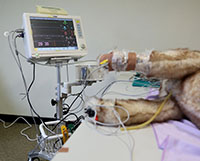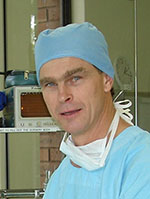Successful surgery begins with effective anaesthesia. Given our current reliance on monitoring equipment to gauge anaesthetic depth and patient status, we should have a thorough understanding of our machines. What equipment should we use for different clinical situations? How do we troubleshoot problems with our machines? How do we interpret the read outs and identify a true alarm amidst all the beeps and trills? Join Dr Colin Dunlop as he discusses the nuances of monitoring pulse oximetry, blood pressure, heart rate, temperature and capnography in the workshop in November. The workshop will comprise of lectures, demonstrations and group discussions using clinical cases.


Dr Colin Dunlop, BVSc, DACVAA
Dr Colin Dunlop is well known in the veterinary world as the director of ‘Advanced Anaesthesia Specialists’, an Australian based veterinary anaesthesia and critical care company whose aim is "to Make Anaesthesia Easier". Being an end-user himself, Colin strives to develop and innovate anaesthetic equipment and techniques for vets. AAS holds 12 international patents for a range of devices and has won an Australian Design Award for its Laryngoscope light. His no-nonsense approach has made Colin a popular speaker and tutor in veterinary anaesthesia courses worldwide. Having gained his specialist qualifications in veterinary anaesthesia in 1986, Colin continues to practice as a specialist anesthetist at Randwick Equine Centre and the Small Animal Specialist Hospital in Sydney.
Information
| Date: | 30 November 2016, Tuesday |
| Time: | 9 am to 5 pm (Registration from 8:30 am) |
| Venue: | Multi-function Room 8210, 8/F, Lau Ming Wai Academic Building (AC3), City University of Hong Kong |
| Fee: | HKD 3,000 |
| CPD: | 7 CPD Points |
Agenda
Given our current reliance on monitoring equipment to gauge anaesthetic depth and patient status, we should have a thorough understanding of our machines. Dr Dunlop will discuss several anaesthetic parameters that are vital for gauging patient status. He will use monitoring equipment to demonstrate various read outs – their importance and their interpretation. You will then form small groups and work through different anaesthetic case scenarios, thus putting into practice the information gained in the earlier part of the day.
| Timetable | |
|---|---|
| 0830-0900: | Registrations |
| 0900-0930: | Anaesthesia morbidity & mortality – DIC: Death isn’t Coming |
| 0930-1015: | Session 1 - Heart Rate |
| 1015-1045: | Coffee break |
| 1045-1130: | Session 2 - Oxygenation |
| 1130-12:15: | Session 3 - Blood Pressure & Perfusion |
| 1215-1300: | Session 4 - Ventilation |
| 1300-1400: | Lunch |
| 1400-1445 | Session 5 - Hypothermia–Does this contribute to death in recovery? |
| 1445-1600 | Practical Session |
| 1600-1700 | Case Review & Discussion, Q&A |
| 1700: | Close of workshop |
For enquiry, please call (852) 3442-6138 or email to cvmls.cpe@cityu.edu.hk
